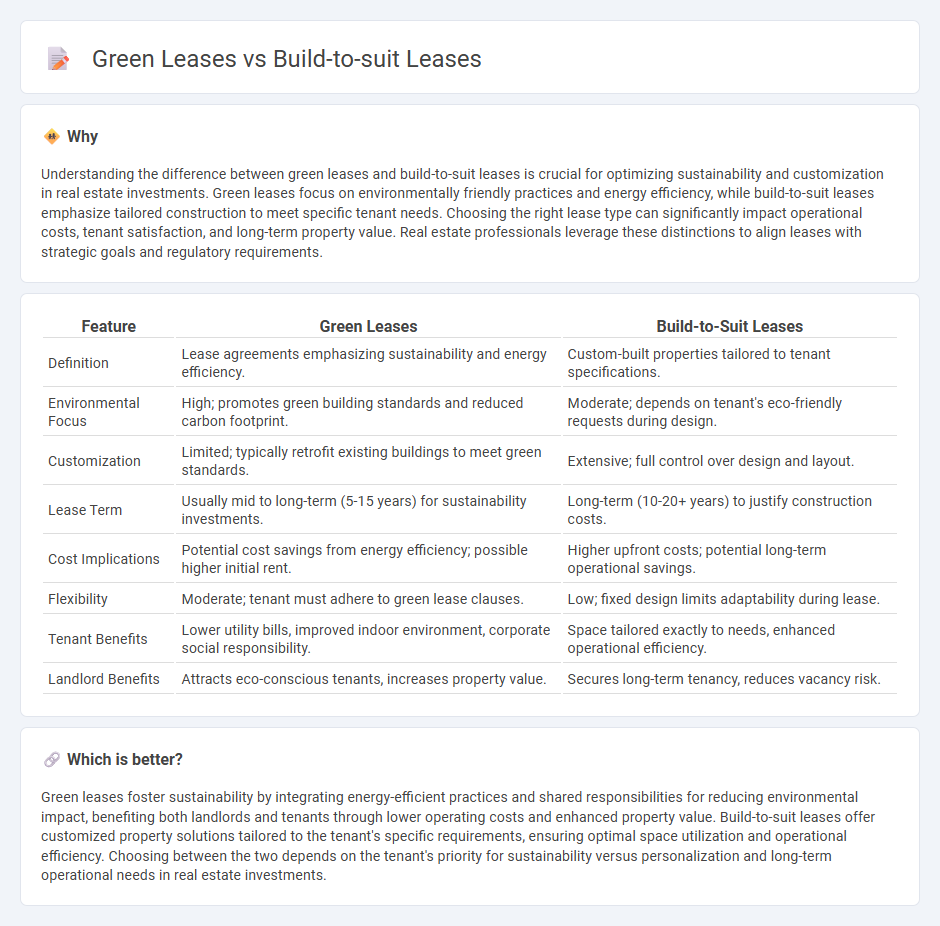
Green leases prioritize sustainability by integrating energy efficiency and environmentally friendly practices into rental agreements, reducing operational costs and carbon footprint. Build-to-suit leases focus on customized property development, allowing tenants to tailor spaces to specific requirements, enhancing functionality and long-term value. Discover the key differences and benefits of these leasing strategies to optimize your real estate investments.
Why it is important
Understanding the difference between green leases and build-to-suit leases is crucial for optimizing sustainability and customization in real estate investments. Green leases focus on environmentally friendly practices and energy efficiency, while build-to-suit leases emphasize tailored construction to meet specific tenant needs. Choosing the right lease type can significantly impact operational costs, tenant satisfaction, and long-term property value. Real estate professionals leverage these distinctions to align leases with strategic goals and regulatory requirements.
Comparison Table
| Feature | Green Leases | Build-to-Suit Leases |
|---|---|---|
| Definition | Lease agreements emphasizing sustainability and energy efficiency. | Custom-built properties tailored to tenant specifications. |
| Environmental Focus | High; promotes green building standards and reduced carbon footprint. | Moderate; depends on tenant's eco-friendly requests during design. |
| Customization | Limited; typically retrofit existing buildings to meet green standards. | Extensive; full control over design and layout. |
| Lease Term | Usually mid to long-term (5-15 years) for sustainability investments. | Long-term (10-20+ years) to justify construction costs. |
| Cost Implications | Potential cost savings from energy efficiency; possible higher initial rent. | Higher upfront costs; potential long-term operational savings. |
| Flexibility | Moderate; tenant must adhere to green lease clauses. | Low; fixed design limits adaptability during lease. |
| Tenant Benefits | Lower utility bills, improved indoor environment, corporate social responsibility. | Space tailored exactly to needs, enhanced operational efficiency. |
| Landlord Benefits | Attracts eco-conscious tenants, increases property value. | Secures long-term tenancy, reduces vacancy risk. |
Which is better?
Green leases foster sustainability by integrating energy-efficient practices and shared responsibilities for reducing environmental impact, benefiting both landlords and tenants through lower operating costs and enhanced property value. Build-to-suit leases offer customized property solutions tailored to the tenant's specific requirements, ensuring optimal space utilization and operational efficiency. Choosing between the two depends on the tenant's priority for sustainability versus personalization and long-term operational needs in real estate investments.
Connection
Green leases and build-to-suit leases intersect by promoting sustainable and customized commercial real estate solutions that align tenant needs with environmental performance goals. Both lease types facilitate energy-efficient building designs and operational practices, allowing tenants to influence green features and landlords to invest in eco-friendly infrastructure. This synergy drives higher property value, reduced operating costs, and compliance with evolving sustainability regulations.
Key Terms
Customization (Build-to-suit leases)
Build-to-suit leases provide tenants with tailored spaces designed to meet specific operational needs, including floor layouts, technological infrastructure, and sustainability features. This high level of customization ensures optimal functionality, efficiency, and tenant satisfaction compared to standard commercial leases. Explore the benefits of personalized commercial property solutions to enhance your business environment.
Sustainability Clauses (Green leases)
Build-to-suit leases offer tailored real estate solutions, while green leases integrate sustainability clauses to promote energy efficiency, waste reduction, and renewable resource use within the leased property. Green lease provisions often include obligations for both landlords and tenants to collaborate on achieving environmental performance goals such as LEED certification or carbon neutrality. Explore the advantages and legal considerations of sustainability clauses in green leases to optimize eco-friendly property management.
Operating Expenses Sharing
Build-to-suit leases tailor commercial properties specifically for tenant needs, often resulting in higher initial costs but optimized operational efficiency. Green leases prioritize sustainability by incorporating clauses that share operating expenses related to energy efficiency, water conservation, and waste reduction between landlords and tenants. Explore more about how these lease structures impact operating expense sharing and sustainability goals.
Source and External Links
Build-to-Suit Leases: Pros and Cons of BTS Leases - This article discusses how build-to-suit leases work, including the benefits and drawbacks for businesses and developers.
Understanding a Build-to-Suit (BTS) Lease in Real Estate Investing - It explains a build-to-suit lease as a custom-built property solution for tenants, where developers cover construction costs and recoup them through long-term leases.
Built to Suit in Commercial Real Estate - This resource describes built-to-suit leasing as a method where developers build properties specifically for tenants, often involving long-term leases to ensure investment returns.
 dowidth.com
dowidth.com